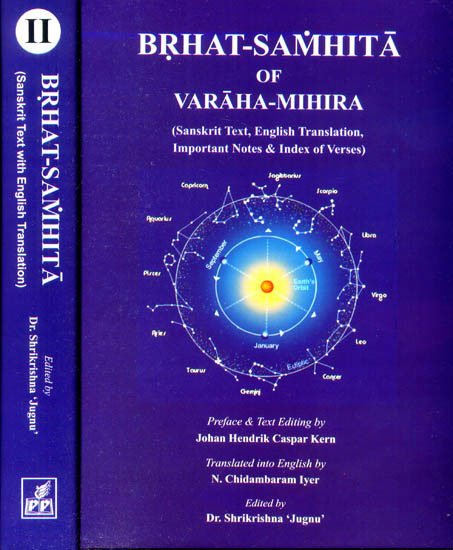Brihat Samhita
by N. Chidambaram Iyer | 1884 | 135,584 words | ISBN-13: 9788171104215
This page describes omens from slits of garments (vastracheda-lakshana) which is the seventy-first Chapter of the English translation of the Brihat-samhita. This work, written by Varahamihira in the 6th century, is classified as jyotisha literature, also known as Indian astronomy. It contains however, also content regarding astrology, palmistry, agriculture, gardening, perfumes, medicines and various other encyclopedic topics.
Chapter 71 - Omens from Slits of Garments (vastracheda-lakṣaṇa)
[Sanskrit text for this chapter is available]
1-7. One who wishes to wear new clothes in the 27 constellations beginning with Aśvinī will experience the following results in order: (1) Acquisition of plenty of good clothes; (2) theft of clothes; (3) burning of the clothes; (4) achievement of objects (or wealth); (5) trouble from rats; (6) death; (7) arrival of auspicious things; (8) influx of wealth; (9) destruction of the clothes; (10) death; (11) trouble from the king; (12) acquisition of money; (13) accomplishment of undertakings; (14) auspicious functions; (15) good food; (16) popularity among the people; (17) meeting of friends; (18) loss of clothes; (19) loss of the same in water; (20) disease; (21) sumptuous feast; (22) eye-disease; (23) gain of corn; (24) great danger from poison; (25) danger through water; (26) birth of a son; and (27) acquisition of precious stones.
8. It is advisable to wear new clothes even under an asterism that is devoid of good qualities, provided it is an occasion of marriage, reception of a king and one approved by worthy Brāhmaṇas.
9. Divide the garment into nine rectangles by lines joining the opposite points of trisection of the sides. The Devas occupy the four rectangles at the corners. The Naras (men) occupy the two middle squares at the two ends, and the Asuras occupy the three remaining central squares. The same remarks apply to seats and shoes.
10. If the inner garment be new, and if it be disfigured with ink, dung, mud and the like, or if it be cut, burnt or torn, the effects whether good or bad will fully come to pass; if the injured garment be one that has been used, the effects will be slightly felt; if the garment be a decayed one, the effects will be very slightly felt. If the outer garment be injured, the effects will be greatly felt.
11. If the injury occur to an Asura part, the person will either suffer from diseases or will die; if it occur to a human part, there will be birth of sons and an improved appearance of the body; if it occur to a Divine part, there will be an increase of comfort. Generally, if the injury occur about the edges, there will be misery.
12. If the cut appearing in the divine parts of a garment be of the shape of a heron, a duck, an owl, a dove, a crow, a hawk, a jackal, an ass, a camel, or a snake, there will be danger to the hie of the person.
13. If the cut in the Asura part of the garment be of the shape of an umbrella, a banner, a cross, a platter a bilva tree, a pot, a lotus flower, a flower wreath and the like, the person will soon become wealthy and prosperous.
14. A new garment presented by Brāhmaṇas with their benedictions or by the king for merit or on occasions of marriage, may be worn irrespective of the position of the stars in the lunar Zodiac and the effects will always be good.
Notes:
If the injured garments be very valuable silks and the like, the effects described will occur after three or six years; in the case of woollen shawls, after three years; and in the case of ordinary garments after six months. According to Garga, whether the injury occur to valuable or ordinary garments, there shall be a recitation of Vedic hymns by the Brāhmaṇas; in the case of torn garments, the evils cannot be escaped by the sale of the garments; they should be given away to Brāhmaṇas with gold, in which case, a person becomes freed from evils.
